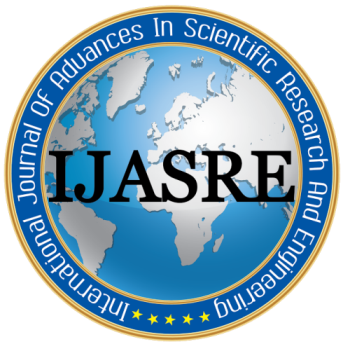Study of Organochlorine Pesticide Residues Analysis in Water, Fish and Sediment using GC-ECD in River Loko, Nasarawa State, Nigeria
DOI:
https://doi.org/10.31695/IJASRE.2022.8.4.6Keywords:
Accumulation, Organochlorines, Pesticides, Aquatic EnvironmentAbstract
Levels of organochlorine pesticide (OCPs) residues in sediment, water and fish in River Loko, Nasarawa State, Nigeria, were evaluated for possible pollution of the aquatic system. Water and sediment samples were collected from the river at 3 locations. Fish caught in the river were bought from fishermen at the bank of the river. The samples were collected in rainy season and preserved according to standard methods. Liquid-liquid extractions of samples were carried out, and then quantified using gas chromatography coupled with electron capture detector (GC-ECD). The OCPs levels ranged from 0.06 to 1.53 µɡ/Kɡ in sediment, 0.03 to 1.34 µɡ/Kɡ in water and 0.02 to 1.34 µɡ/Kɡ in fish. 2, 4-Dichlorophenoxacetic acid (2,4-D) was the most accumulated OCP in sediment (1.64±0.10 µɡ/Kɡ), water (1.34±0.08 µɡ/Kɡ), and fish (1.34 µɡ/Kɡ). Concentrations of OCPs generally varied in the order of sediment > water > water ~ fish. ANOVA shows that concentrations of OCPs in water and fish were significantly (p ≤ 0.05) lower compared to sediment, except for mecoprop, imidacloprid, 2,4-D, and aldrin, which were not significantly different in the samples. Pearson correlation matrix for OCPs in water and sediment show moderate to very strong and positive correlations except for mecoprop (-0.705), alachlor (-0.217), imidacloprid (-0.082), permethrin (-0.339) and aldrin (-0.795).Concentrations of OCPs were within the FAO/WHO acceptable limits except for aldrin, mecoprop, metolachlor, simazine, DDT and dieldrin. Regular monitoring of the quality of River Loko becomes necessary due to accumulation of OCPs.
References
. Gavrilescu, M. (2005). The fate of pesticides in the environment and its bioremediation.English Life Science, 5(6),
-526.
. Jeyakumar, T., Kalaiarasi, I., Rajave, A.L., Anbu, M., & Kumar, R. (2014). Levels of organochlorine pesticide residues in water and sediment from selected agricultural sectors of Kanyakumari District, Tamil Nadu, India. International Journal of Environmental Research, 8(2), 493–500.
. Wang, X., Sheng, J., Gong, P., Xue, Y., Yao, T., & Jones, K.C. (2012) Persistent organic pollutants in the Tibetan surface soil: spatial distribution, air-soil exchange and implications for global cycling. Environmental Pollution, 170, 145–151.
. Darko, G., Akoto, O., & Oppong, C. (2008). Persistent organochlorine pesticide residues in fish, sediments, and water from lake Bosomtwi, Ghana. Chemosphere, 72, 21–24.
. Akoto, O., Gavor, S., Appah, M.K., & Apau, J. (2013) Estimation of human health risk associated with the
consumption of pesticide- contaminated vegetables from Kumasi, Ghana. Environ Monit Assess;
(5):244. doi: 10.1007/s10661- 015-4471-0.
. AOAC International Official method (2007). Pesticide residues in foods by acetonitrile extraction and
partitioning with magnesium sulfate.AOACInternational, 2007.
. US EPA Method 1699 (2007). Pesticides in water, soil, sediment, biosolids, and tissue by high-resolution gas chromatography with high-resolution mass spectrometry. Available online at www.water.epa.gov (accessed 6th August 2012).
. Musa, S., Wageni,J., Gichuki, P., Okoth, R., & Mulanda, C. A. (2011). Organochlorine and organophosphorus pesticide residues in water and sediment from Yala/Nzoia River within Lake Victoria Basin, Kenya. Journal of Ecology and the Natural Environment, 3(12), 392-399.
. Osei A., Augustine Asore, A., & Adotey, K. D. (2016). Pesticide residues in water, sediment, and fish from Tono Reservoir and their health risk implications. Springerplus, 5(1), 1849.
. Singh, L., Choudhary, S. K., Singh, P. K. (2012). Pesticide concentration in water and sediment of River Ganga at selected sites in middle Ganga plain.International Journal of Environmental Sciences, 1(3), 261-273.
. Farshid, K., Amir, H. S., Rokhsareh, M., & Hamid, N.A. (2012). Determination of Organochlorine Pesticide
Residues in water, Sediments, and Fish from Lake Parishan, Iran.World Journal of Fish and
Marine Sciences,4(2), 150-154.
. Idowu, G. A., Aiyesanmi., A. F., & Owolabi, B. J. (2013). Organochlorine pesticide residue
levels in river water and sediment from cocoa-producing areas of Ondo State central senatorial
district, Nigeria.Journal of Environmental Chemistry and Ecotoxicology, 5(9), 242-249.
. FAO/WHO (2011). Pesticide residues in food and feed.Acceptable daily intake; Codex Alimentarius
Commission. Rome: FAO/WHO Food Standards.
. Akan, J.C., Sodipo, O.A., Mohammed, Z., & Abdulrahman, F. (2014). Determination of organochlorine, organophosphorus and pyrethroid pesticide residues in water and sediment samples by high-performance liquid chromatography (HPLC) with UV/visible detector. Journal of Bioanalytical Technique, 5, 226.
. Caldas, E.D., Coelho, R., Souza, L.C.K.R., & Siba, S.C. (1999).Organochlorine pesticides in water,
sediment, and fish of Paranoá Lake of Brasilia, Brazil.Bulletin on Environmental Contamination
Toxicology.62,199–206.
. Adeyemi, D., Anyakora, C., Ukpo, G., Adedayo, A., & Darko, G. (2011). Evaluation of the levels of organochlorine pesticide residues in water samples of Lagos Lagoon using solid phase extraction method. Journal of Environmental Chemistry Ecotoxicology, 3(6), 160–166.
Akan, J. C., Mohammed, Z., Jafiya, L., & Audu, S.I. (2013). Organophosphorus Pesticide Residues in Different Tissues ofFish Samples from Alau Dam, Borno State, Nigeria.World Journal of Fish and Marine Sciences, 5(5), 519-526.
Downloads
How to Cite
Issue
Section
License
Copyright (c) 2022 Osuegba O. S, Tukura B W, Bulus Y E, Atolaiye B. O

This work is licensed under a Creative Commons Attribution-NonCommercial 4.0 International License.








